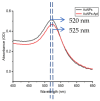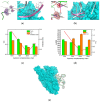The Development of Aptamer-Based Gold Nanoparticle Lateral Flow Test Strips for the Detection of SARS-CoV-2 S Proteins on the Surface of Cold-Chain Food Packaging
- PMID: 38675595
- PMCID: PMC11052266
- DOI: 10.3390/molecules29081776
The Development of Aptamer-Based Gold Nanoparticle Lateral Flow Test Strips for the Detection of SARS-CoV-2 S Proteins on the Surface of Cold-Chain Food Packaging
Abstract
The COVID-19 pandemic over recent years has shown a great need for the rapid, low-cost, and on-site detection of severe acute respiratory syndrome coronavirus 2 (SARS-CoV-2). In this study, an aptamer-based colloidal gold nanoparticle lateral flow test strip was well developed to realize the visual detection of wild-type SARS-CoV-2 spike proteins (SPs) and multiple variants. Under the optimal reaction conditions, a low detection limit of SARS-CoV-2 S proteins of 0.68 nM was acquired, and the actual detection recovery was 83.3% to 108.8% for real-world samples. This suggests a potential tool for the prompt detection of SARS-CoV-2 with good sensitivity and accuracy, and a new method for the development of alternative antibody test strips for the detection of other viral targets.
Keywords: AuNPs; COVID-19; S protein; SARS-CoV-2; aptamer; lateral flow test strips.
Conflict of interest statement
The authors declare no conflicts of interest. The funders had no role in the design of the study; in the collection, analyses, or interpretation of data; in the writing of the manuscript; or in the decision to publish the results.
Figures











Similar articles
-
Comparison of Six Aptamer-Aptamer Pairs on Rapid Detection of SARS-CoV-2 by Lateral Flow Assay.J AOAC Int. 2024 May 2;107(3):464-470. doi: 10.1093/jaoacint/qsae004. J AOAC Int. 2024. PMID: 38218729
-
Development of aptamer-based lateral flow devices for rapid detection of SARS-CoV-2 S protein and uncertainty assessment.Talanta. 2025 Jan 1;281:126825. doi: 10.1016/j.talanta.2024.126825. Epub 2024 Sep 7. Talanta. 2025. PMID: 39276574
-
Differential detection of SARS-CoV-2 variants and influenza A viruses utilizing a dual lateral flow strip based on colloidal gold-labeled monoclonal antibodies.Int J Biol Macromol. 2024 Nov;280(Pt 4):136067. doi: 10.1016/j.ijbiomac.2024.136067. Epub 2024 Sep 26. Int J Biol Macromol. 2024. Retraction in: Int J Biol Macromol. 2025 May;305(Pt 2):141045. doi: 10.1016/j.ijbiomac.2025.141045. PMID: 39341304 Retracted.
-
Updates on the Biofunctionalization of Gold Nanoparticles for the Rapid and Sensitive Multiplatform Diagnosis of SARS-CoV-2 Virus and Its Proteins: From Computational Models to Validation in Human Samples.Int J Mol Sci. 2023 May 25;24(11):9249. doi: 10.3390/ijms24119249. Int J Mol Sci. 2023. PMID: 37298201 Free PMC article. Review.
-
Gold nanoparticles in virus detection: Recent advances and potential considerations for SARS-CoV-2 testing development.Wiley Interdiscip Rev Nanomed Nanobiotechnol. 2022 Jan;14(1):e1754. doi: 10.1002/wnan.1754. Epub 2021 Sep 8. Wiley Interdiscip Rev Nanomed Nanobiotechnol. 2022. PMID: 34498423 Free PMC article. Review.
Cited by
-
Aptamer-Conjugated Multi-Quantum Dot-Embedded Silica Nanoparticles for Lateral Flow Immunoassay.Biosensors (Basel). 2025 Jan 16;15(1):54. doi: 10.3390/bios15010054. Biosensors (Basel). 2025. PMID: 39852105 Free PMC article.
-
Advances in nucleic acid aptamer-based detection of respiratory virus and bacteria: a mini review.Virol J. 2024 Sep 30;21(1):237. doi: 10.1186/s12985-024-02513-9. Virol J. 2024. PMID: 39350296 Free PMC article. Review.
-
Ultra-Sensitive Aptamer-Based Diagnostic Systems for Rapid Detection of All SARS-CoV-2 Variants.Int J Mol Sci. 2025 Jan 16;26(2):745. doi: 10.3390/ijms26020745. Int J Mol Sci. 2025. PMID: 39859459 Free PMC article.
References
-
- World Health Organization WHO Coronavirus (COVID-19) Dashboard. [(accessed on 17 January 2024)];2024 Available online: https://covid19.who.int/
MeSH terms
Substances
Supplementary concepts
Grants and funding
LinkOut - more resources
Full Text Sources
Medical
Miscellaneous

